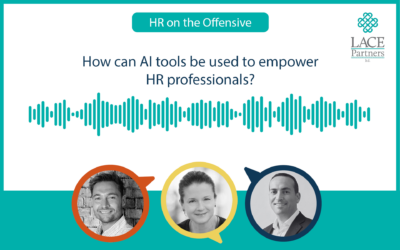Recently some members of the LACE team took part in the Evanta CHRO Summit in London, bringing together just under 100 CHRO/CPOs from a wide variety of industry sizes and sectors. Today’s blog focuses on the boardroom discussion we were asked to lead on, which focused on how HR can close the gap between the employee value proposition (EVP) and employee experience to improve overall workforce performance.
In today’s dynamic business landscape, organisations face numerous challenges when it comes to bringing their Employee Value Proposition (EVP) to life. Today we’re exploring the key obstacles faced by businesses and provides insights into strategies for mobilising and integrating EVPs during mergers, building a consistent EVP across fragmented businesses, and striking a balance between driving the employer brand, values, purpose, and maintaining a performance-driven culture.
Mobilising and integrating EVPs during merger
When organisations undergo mergers or integrations of different cultures, the challenge arises of combining and aligning separate EVPs. Some of the attendees we spoke to at the Evanta CHRO summit talked in detail about the impact that mergers and acquisitions (M&A) have on building that unified EVP. For some of the attendees a critical step in this process was the relaunch of the EVP across the entire business. However, many of the attendees at our roundtable agreed that a common challenge was how to make the EVP “real” for employees with diverse personas and interests. For example, employees on the shop floor may have different demands and expectations compared to those in head office positions. Articulating the importance of buy-in and addressing the concerns of employees who prioritise compensation is crucial in ensuring the success of the integrated EVP.
Some of the delegates admitted that their employees often struggle to understand how the EVP relates to them personally and what actions they can take to embody it. Recognising the different employee personas within an organisation is essential for tailoring the EVP and creating a sense of relevance and engagement. For example, new hires have different expectations and experiences compared to long-term employees, so recognising that these different personas exist dependent on the lifecycle of where the employee is at in their journey is critical, then adapting the EVP accordingly is important. By acknowledging the unique needs and aspirations of each persona, organisations can foster a stronger connection between their employees and the EVP.
Building a consistent EVP across fragmented businesses
Fragmentation of course can exist when businesses have merged or acquired new businesses, but the challenges remain consistent wherever there is fragmentation across an organisation. Many of the CPO/CHROs we spoke to at the Evanta summit acknowledged that where they have a fragmented workforce, such as those with multiple practices forming part of a group, they face the challenge of maintaining a consistent EVP. In some instances each business unit may have its own identity and EVP, making it challenging to achieve unified messaging and engagement. To overcome this hurdle, some of the CPOs we spoke to talked about how they focus on increasing employee engagement through working groups that bring together employees from different locations and practices. This approach fosters consistency and alignment in the EVP, ensuring that the overall message resonates with employees across the organisation.
Overcoming resistance and embracing EVP ownership
Despite the willingness of employees to volunteer for focus/working groups, our boardroom discussion moved on to debate how getting senior leaders to embrace the EVP process can be difficult. Some leaders perceive EVP as solely an HR exercise, failing to recognise the broader organisational responsibility it carries. To overcome this resistance, organisations must emphasise that EVP ownership should be distributed throughout the entire business. While HR plays a crucial role as the “guardian” of EVP, it is essential for all employees to take ownership and contribute to its development and implementation.
HR holds a vital role in reflecting the organisation’s values, purpose, and EVP to the rest of the business. By holding up the mirror, HR can assess whether the EVP aligns with the organisation’s goals and culture. HR professionals are tasked with ensuring that the EVP remains relevant, authentic, and meaningful for employees. Additionally, organisations can tie incentives and bonuses to the employee net promoter score (eNPS) to reinforce the EVP’s importance and measure its impact on employee engagement and satisfaction.
Balancing employer brand, values, purpose, and performance
Maintaining a delicate balance between a strong employer brand, organisational values, purpose, and a performance-driven culture is a key challenge for organisations. As we have previously highlighted in blogs on our website, this is where ‘The Engagement Equation’ is key.

For example, a charity organisation may have a clear sense of purpose that resonates with employees, but it must also maintain a focus on performance to sustain itself. Similarly, private-equity backed businesses face the challenge of aligning their EVP, culture, and performance-driven focus with the expectations of their investors. Striking the right balance requires thoughtful navigation and a shared understanding among all stakeholders.
Demonstrating the EVP: Employer brand videos and authenticity
High-profile businesses often struggle to bridge the gap between external perception and the reality of their EVP and for one of our attendees in the session they spoke of how they look to address this challenge, by leveraging employer brand videos that showcase different employee personas, providing an authentic representation of what it is genuinely like to work within the organization. By “bringing to life” the EVP through these videos, organisations can demonstrate the alignment between external perception, public relations efforts, and the compelling reality of their EVP to both existing and potential employees.
Bringing an EVP to life is a complex process that requires careful consideration and strategic implementation. By tailoring the EVP to employee personas, fostering ownership across the organisation, and leveraging HR’s role in upholding the mirror to the business, organisations can create a powerful EVP that resonates with employees and drives engagement.
Ultimately, authenticity and a commitment to aligning the EVP with the business goals and culture are essential for bringing it to life and realising its full potential.
If you’d like to talk to us about how you shape your EVP, or if you are a CPO/CHRO and are interested in being part of our community, fill in the below form and get in touch and we’d be happy to chat.






